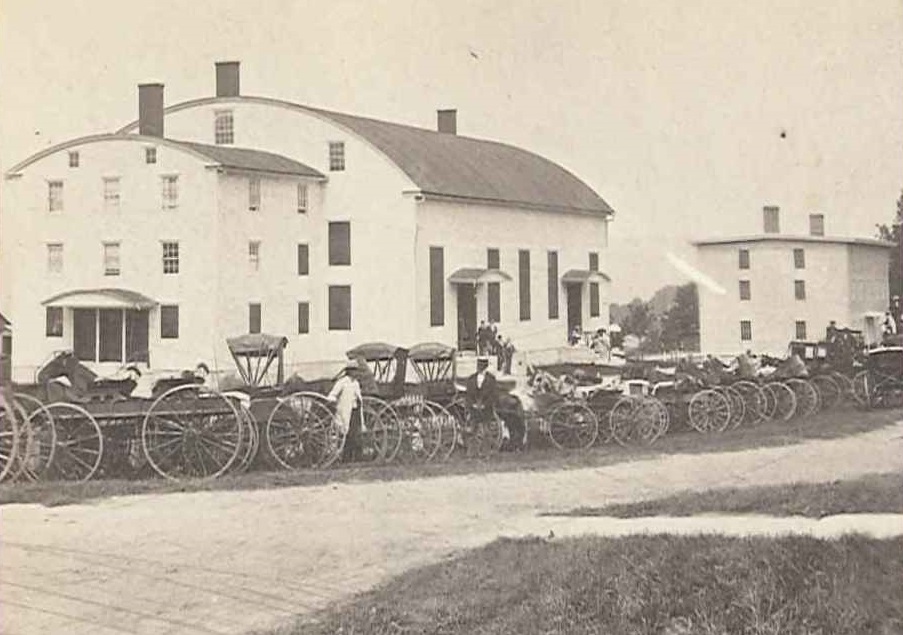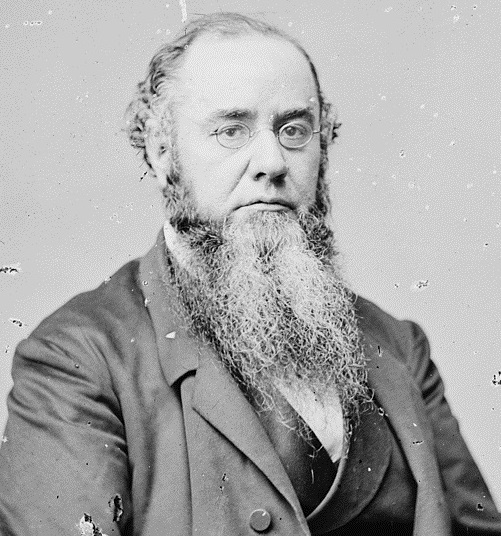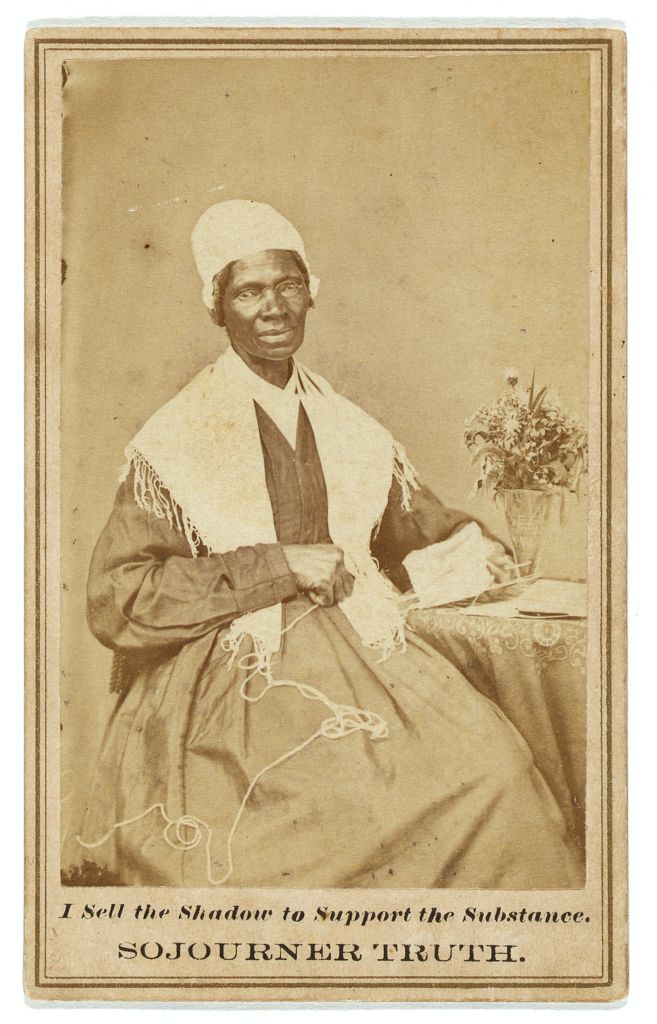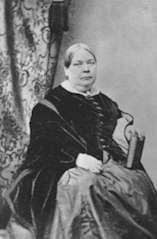
Stereograph, Carriages Tied in Front of Meetinghouse at Mount Lebanon, NY. James Irving, photographer. Shaker Museum | Mount Lebanon 1950.4102.1.
Though Shakers lived separated from the world to the degree possible, worldly guests were permitted, and some visitors were important figures in American history. The first, and most often only, point of contact for visitors was through attending public worship meetings. Mount Lebanon journals document a number of well-known guests. On June 26, 1864, Eldress […]
Though Shakers lived separated from the world to the degree possible, worldly guests were permitted, and some visitors were important figures in American history.
The first, and most often only, point of contact for visitors was through attending public worship meetings. Mount Lebanon journals document a number of well-known guests.
On June 26, 1864, Eldress Polly Reed noted, “General Tom Thumb here to day at public meeting.” Political figures went to public meeting as well; on June 26, 1887, Eldress Augusta Stone wrote, “The Mayor of Albany attended our meeting with three others, 1 man and two women.” At that time, the mayor of Albany was Anthony Bleecker Banks, who served two terms as mayor and was also a member of the New York State Senate, and ran a company that published law books. Elder Rufus Bishop wrote on January 19, 1851, “The Elders from the North family attended the public meeting & Br. Frederick W. Evans addressed the spectators in an able discourse of about an hour, & was followed by Benjamin S. Youngs & Rebecca Jackson. Some of the members of the Legislature were present, among whom was the Lieutenant Governor of the State of New York.” Sanford Elias Church (1815–1880) was elected to the office of Lieutenant Governor in 1850, and served until 1854. He was also the New York State Comptroller (1858-1859), and chief judge of the New York State Court of Appeals from 1870 until his death. Mr. Church had the opportunity to see Mother Rebecca Jackson preach; she was an African-American woman who founded a Shaker community in Philadelphia, PA.
Another important political figure to visit the Shakers was Edwin M. Stanton, Secretary of War to President Abraham Lincoln. The Shakers had met and corresponded with Stanton and Lincoln when seeking military exemptions for brethren during the Civil War. Brothers Benjamin Gates and Andrew Barrett met with Stanton while on a trip to Canada on September 12, 1867, and invited him to visit the Shakers. Stanton accepted, arriving at Mount Lebanon on September 17 with his family. Ten days later he wrote to the Shakers, “[Ten-year-old daughter] Ellie insists that she would much rather go back to the Sisters than go to Washington or New York.”

The Shakers also welcomed guests to lecture on a variety of intellectual and philosophical topics of interest to the Shaker community. On January 13, 1885, the Church Family heard a lecture from a Professor Chandler on the subject of geology. On November 21 of that year, the Center Family at Mount Lebanon invited Nelson Sizer to speak. Sizer had performed a phrenological reading on Sister Emma J. Neale two months before; Eldress Augusta Stone noted in her journal that “all who were able and anxious were permitted to enjoy, it was very interesting.” Three weeks later, the Center Family hosted a Dr. Hughes, “a new Minister in Town,” who gave “a lecture on Eastern mysticism.” And in May of 1887, Clara Fields of the Church Family invited Clara Fields to speak. According to the Church Family journal, Fields “claim[ed] to be a psychometrist of much note.” She gave a lecture to the family that evening. Today psychometrists test neuropsychological functions; the journal does not indicate what work Ms. Fields performed, or what she discussed in her lecture. More remarkably, the Shakers hosted former enslaved person Sojourner Truth in July of 1856. The Church Family journal described her as “a peculiar intellectual character.” Eldress Polly Reed noted, “[She] was freed at the emancipation of slavery in New York State in 1827. Since which time she has been lecturing more or less on the terrors of slavery…. She has had her life written by a friend, (for she can neither read nor write herself,) & sells her pamphlets for 25 cents each. We took two of them.”

Another well-known visitor to the Mount Lebanon Shakers was Elizabeth Blackwell, the first woman to receive a medical degree in America. According to Eldress Polly Reed’s journal, two sisters, Sarah and Phebe Smith, had gone to see Dr. Blackwell in New York City. On July 19, 1856, she arrived at Mount Lebanon. The Shakers took her for a tour of the Lebanon springs, a popular therapeutic tourist destination, and “round to our out farms,” then enjoyed “a pleasant & agreeable ride.” Five days later, Eldress Polly recorded, “Elizabeth is occupied to day in seeing a number of our sisters & prescribing for their various isms. Elder Sister [Eliza Ann Taylor] attends with her at the Physicians shop, where examinations are made.” The Shakers called upon doctors from the outside world as necessary, and given their stance toward gender equality, it isn’t surprising they’d seek out America’s first female doctor.
A less well-known but still significant doctor visited the North Family at Mount Lebanon on September 22, 1851. Elder Rufus Bishop wrote, “Harriet Hunt, the Doctoress came to the North house yesterday, and to the Office to day.”

Harriet, or Harriot, K. Hunt (1805-1875) ran a school from her family home with her sister Sarah, and became interested in studying medicine when Sarah was treated for tuberculosis by a Dr. Richard and Elizabeth Mott. She went to work and study with the Motts, and began to practice as a physician in 1830. She applied to Harvard Medical School, and was rejected; upon Elizabeth Blackwell’s graduation from Geneva Medical College in 1849, she again applied to Harvard and was again rejected. But she continued to practice as a physician, advocating for healthy diets and lifestyles, and homeopathic medicines, much as the Shakers did. In 1850, she helped to organize and spoke at the first Women’s Rights Convention, held in Worcester, Massachusetts, at which she identified the Shakers as proponents of women’s rights.